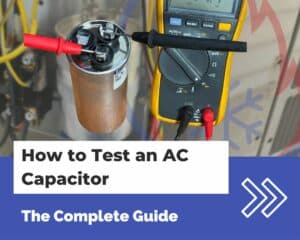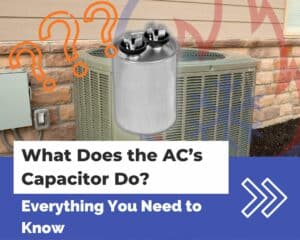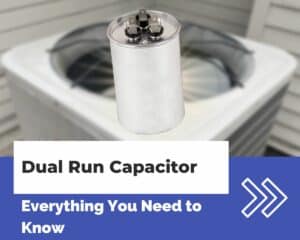One of the most common reasons for a broken AC or furnace is a failed capacitor.
In fact, the capacitor is one of the first things that a technician will check when your HVAC system goes down.
But what is the capacitor used for anyway? And what’s the difference between a start capacitor and a run capacitor?
A start capacitor provides an initial jolt of electricity to get a motor running, whereas a run capacitor helps keep the motor running smoothly.
In this article, I’ll go over the differences between a start capacitor and a run capacitor.
I’ll also explain how these two types of capacitors work, and why some AC compressors have both of them.
How do you tell the difference between a start and run capacitor?
A start capacitor has a black plastic case, whereas a run capacitor has a metallic exterior.

Additionally, start and run capacitors have different functions:
- Start capacitors need to deliver a high amount of charge over a short (<1 second) period of time. For this reason, start capacitors are designed for momentary use.
- Run capacitors are designed to deliver a moderate amount of charge and will stay in the motor’s circuit while the motor is running. For this reason, run capacitors are designed for continuous use.
When working with HVAC systems, run capacitors are much more common.
Run capacitors are found hooked up to blowers, compressors, condenser fans, and sometimes even inducers.
Start capacitors in HVAC systems are rare.
In fact, the only place that you’re likely to find a start capacitor is in an AC condensing unit—connected to the compressor.
Even then, not all AC condensing units have start capacitors, since it’s cheaper to manufacture a condensing unit without one and they’re not always needed.
How a start capacitor works
A start capacitor works by creating a leading current in the motor’s start winding. The leading current creates a rotating magnetic field that the motor uses to start with an increased amount of torque.
After the motor starts up, the start capacitor and start winding are disconnected from the circuit, leaving the main winding to handle the load on its own.
So why is a start capacitor needed, anyway?
A start capacitor is required because a split-phase electric motor can not produce a rotating magnetic field on its own. A rotating magnetic field is required to start an electric motor.
Start capacitors are used in motors that require a high amount of starting torque. For example, you might find a start capacitor hooked up to your AC compressor in the form of a hard start kit (more on this later).
How a run capacitor works
A run capacitor works by creating a leading current in the motor’s auxiliary winding. The leading current creates a rotating magnetic field that helps the motor start. Once the motor is running, the run capacitor helps the motor run more efficiently.
Run capacitors are used in permanent split capacitor (PSC) motors—like those found in your home’s AC or furnace.
So why is a run capacitor needed for a PSC motor to work?
A run capacitor is needed to produce a rotating magnetic field in a PSC motor. The rotating magnetic field produces the torque required to start the motor. The run capacitor also helps the motor operate more efficiently.
One advantage of using a PSC motor with a run capacitor is its efficiency. PSC motors run more efficiently than capacitor start motors since the auxiliary winding stays energized while the motor is in operation.
The main drawback of a PSC motor is that it doesn’t have a high amount of starting torque.
But that’s not a big deal.
Most fans and compressors in HVAC systems use PSC motors—these devices generally don’t require a lot of starting torque.
Compressors and fans are designed to run continuously, so the increased efficiency from a run capacitor is highly beneficial.
In this case, your HVAC equipment will operate more efficiently and save you on energy costs in the long run.
Run capacitor farad rating
In order for your PSC motor to operate at maximum efficiency, its run capacitor must have the correct farad rating.
If a capacitor with the wrong farad rating is installed, then the motor’s windings won’t have an even magnetic field. This makes the electric motor “hesitiate” at certain points in its rotation—causing inefficiencies.
In the worst case, an incorrect farad rating on your motor’s run capacitor will cause your motor to overheat and burn out.
What about AC compressors that have both start AND run capacitors?
Some AC compressors have both start AND run capacitors.
The start capacitor for an AC compressor comes in a hard start kit.
The hard start kit consists of a start capacitor and an additional device that removes the start capacitor from the circuit after the compressor starts up.
If the start capacitor stays in the circuit after the motor starts, the compressor’s motor windings will overheat and burn out.
After the motor starts, the run capacitor stays in the circuit and helps the compressor motor run more efficiently.




I bought a really decent air compressor for a tenner. Listed as spares/repair, it was clearly a faulty start capacitor, as the plastic case was bulged. Using the info on this site, I got a 4uF one for 15% of the price of the ‘correct’ one. So for £13.55 I now own a nearly new compressor. Thank you HVAC Shop!
BTW, the first time I tried it was to inflate a large ex RNLI inflatable boat. I started it up and looked at the clock in my car. Around 50 sec later, I looked at the boat and it was close to going Bang. I was expecting 20-30 minutes. Clearly the calculation I made from the rating was way out 🙂
Hi Ian,
Glad that you found my article helpful and were able to fix your air compressor!
Best regards,
-Trey